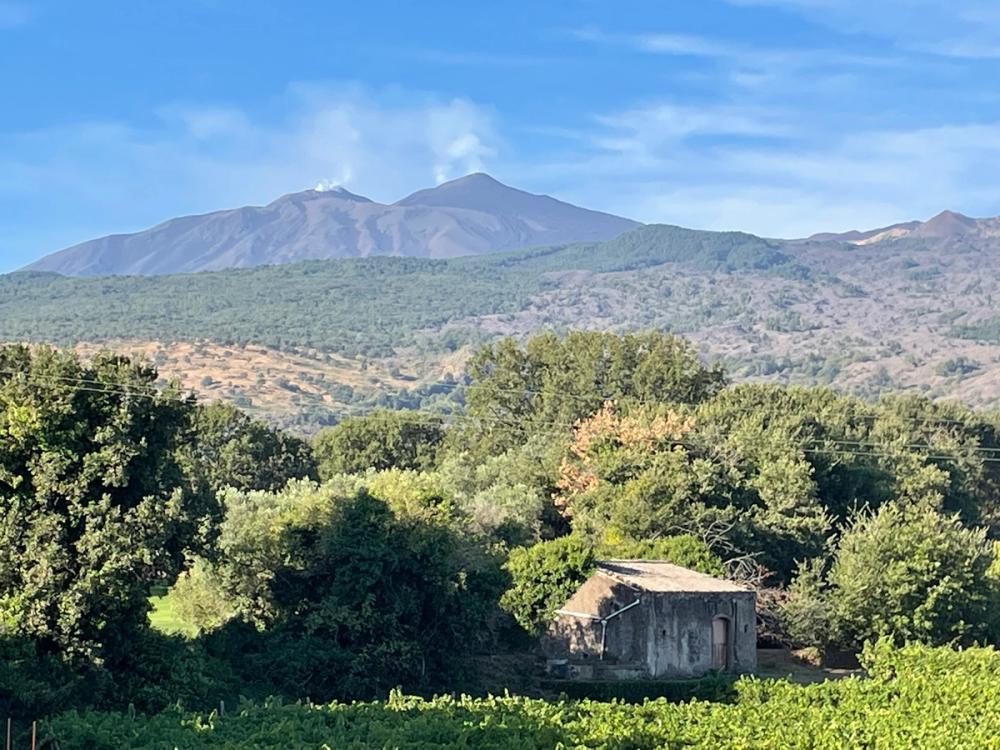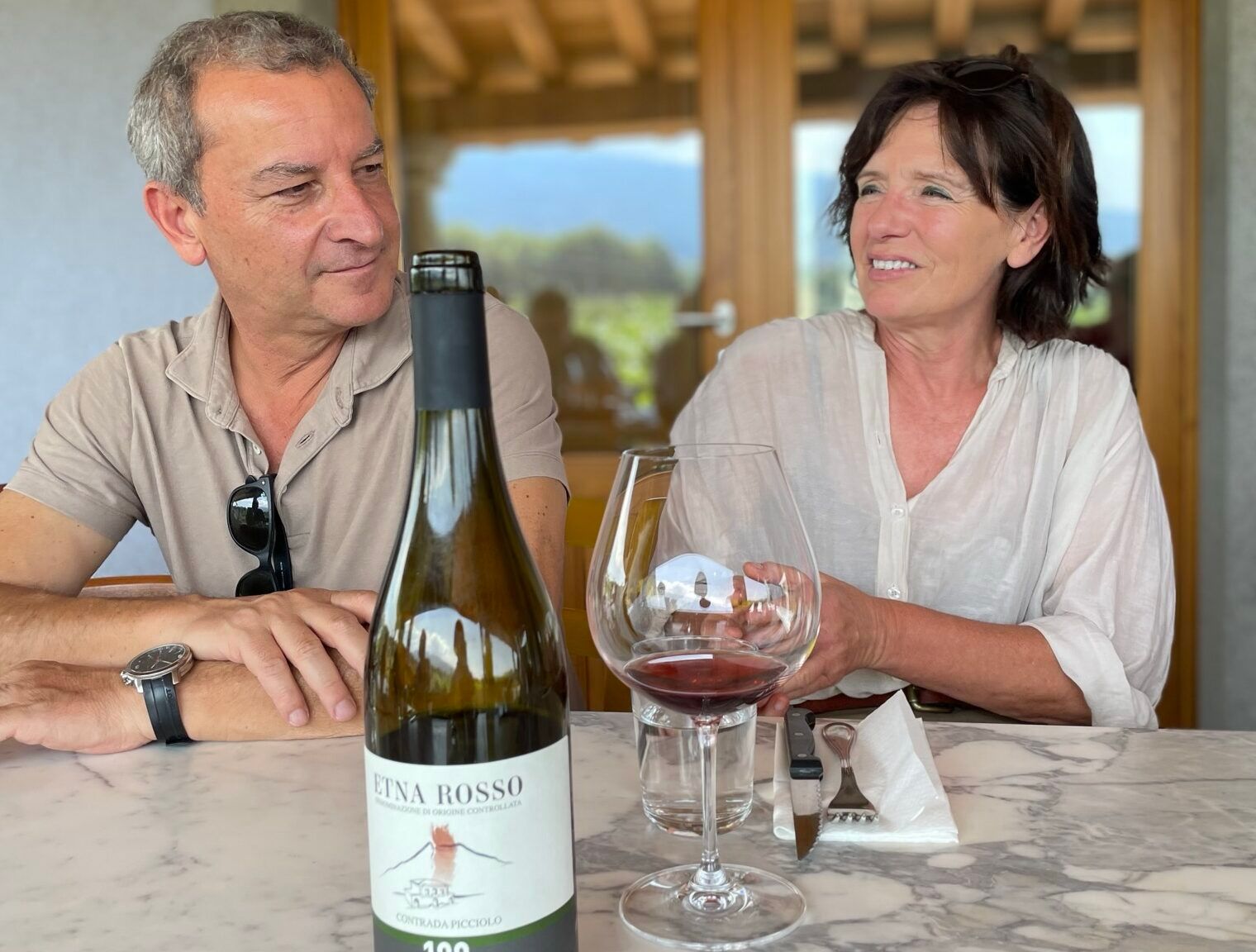“We have a few exciting future plans such as pushing for sustainability certification and moving toward obtaining DOCG status. Both, I believe, will also help the wine trade better communicate (Nerello Mascalese) wines from Etna in the near future,” says Lunetta.

Mount Etna, constantly spewing smoke
Not many wine regions around the globe contend with persistent alterations in their landscape, whether in territorial boundaries or soil composition. Yet, in Etna DOC, vintners must acclimatise to such changes due to frequent volcanic eruptions, the most recent of which occurred on the 25th of November. Just as every cloud has a silver lining, each eruption brings benefits to the vineyards. Volcanic ashes add a layer and renew the soil with each eruption, incorporating dozens of minerals as natural fertiliser.
For Nerello Mascalese, a grape that some growers describe as a prima donna due to its high sensitivity to growing conditions, the ever-changing terroirs of Etna provide the perfect stage for it to showcase its brilliance. “Nerello” indicates it is a black grape, and “Mascalese” suggests its origin in Mascali, around 30 km northeast of Catania. Believed to be an offspring of Sangiovese and Mantonico Bianco, the grape takes centre stage in Etna Rosso, Rosso Riserva, Rosato, and Spumante wines.
Nerello Mascalese can be crafted as a single varietal or, at a minimum, 80 per cent, with mainly Nerello Cappuccio as the blending partner, resulting in wines with a pale colour, silky tannin, high acidity, vibrant fruit character, and great ageing potential. Despite its uniqueness, local producers often compare it to Nebbiolo and Pinot Noir, the former due to its late ripening occurring typically in the second half of October, and the latter due to its sensitivity to local conditions.

Maurizio Lunetta, director of Etna DOC and owner of Casale 120 winery and partner Margriet
However, Maurizio Lunetta, the director of the Consorzio Tutela Dei Vini Etna DOC, begs to differ. He believes that drawing comparisons to other varieties is not the best way to highlight the unique selling point of Nerello Mascalese from Etna.
“Discussing the grape variety alone or comparing it with others is not helpful for consumers to fully appreciate it,” argues Lunetta. “It is the Etna terroir that makes everything growing here special,” he explains. Indeed, with volcanic ashes making it hard for phylloxera to reach, another USP of Etna DOC is the existence of many ungrafted vines, giving the wine a distinct character and a note of minerality. “For me, the key message should always be Etna first, the grape variety second. Since you can find Nerello Mascalese growing even in Turkey!” says Lunetta.
Trying to understand Etna terroir

Marco de Grazia of Tenuta delle Terre Nere
But to understand the Etna terroir also proves to be a challenge. After all, as Marco de Grazia of Tenuta delle Terre Nere puts it, Etna is “the Burgundy of the Mediterranean” with incredibly diverse soil composition. Etna DOC stretches across three sides of the volcano’s extension like a crescent moon, surrounding the volcano from north to southwest.
The complexity of the terroir manifests itself through contrade, the historical sub-zones which consider not only the vineyard’s exposure but also the various layers created by the lava flows. In 2011, 133 of them were identified, and in 2022, nine more were added.
“We know that remembering the names of hundreds of contrade and understanding their different nuances is best left to wine geeks,” remarks Lunetta. “When talking to consumers, I believe discussing the different slopes is much easier to understand,” he adds.
Of the original 133 contrade, 81 are situated on the northern slope, and this is the land of Nerello Mascalese. With gentle inclines and a cooler climate, well-sheltered by mountain ranges. Vineyards extend up to 800 meters above sea level, offering a substantial diurnal range, particularly suitable for the site-sensitive Nerello Mascalese, resulting in the production of complex and outstanding wines.

A view from Tenute Ballasanti on Etna’s eastern slope
The southeastern slope, adorned with extinct eruptive cones, boasts many bush-vine-trained Nerello Mascalese and Carricante. Benefiting from abundant sun exposure and refreshing sea breezes, wines here attain perfect ripeness more easily, yielding some stunning, fruit-driven examples.
Facing the Ionian Sea, the eastern slope is exposed to rain and winds, while the farthest southwestern slope features hot winds and intense sunlight, conditions less ideal for Nerello Mascalese but better suited for Carricante.
Apart from the slopes and the contrade, is there anything else that can help nail the sale of Nerello Mascalese?
“We have a few exciting future plans such as pushing for sustainability certification and moving toward obtaining DOCG status. Both, I believe, will also help the wine trade better communicate wines from Etna in the near future,” concludes Lunetta.
Nine Nerello Mascalese wines from Etna to put on your radar

Feudo Cavaliere’s terranced vineyard on the southwestern slope
Southwestern slope
Feudo Cavaliere Millemetri Etna Rosso 2012
A family winery founded in 1880, with many pre-phylloxera vines that are over 300 years old. The Nerello Mascalese grapes for this wine come from altitudes between 950-1500m, hence the name of the wine. The perfumed nose exhibits violet, vibrant cranberry, and cherry notes, leading to a more restrained and tight palate with brilliant fresh acidity, showcasing the impressive ageing potential of the wine.
Southeastern slope
Murgo Extra Brut 2016
Nerello Mascalese is harvested early to retain acidity, undergoing gentle pressing. The first fermentation occurs in stainless steel, subsequently eight months of ageing. A second fermentation in the bottle, along with 24 months on lees, results in an elegant sparkling wine with charming peach and honey tones, subtly mingled with a brioche note and bright acidity.
Eastern slope
Tenute Ballasanti, Il Sublime 2020
The winery’s captivating story begins with the union of Manuela Seminara, deeply connected to Sicily, and Fabio Gualandris, an astrophysicist and semiconductor expert. Their innovative wine estate, rooted in family history, produces wines with distinct personalities. Nerello Mascalese for Il Sublime comes from a century-old vineyard on Etna’s steep slopes, resulting in a rich wine with silky tannins, and charming notes of wild red berries and spices.
Northern slope
Monteleone “Rumex” 2021
Founded in 2017, Monteleone is a family business led by Giulia Monteleone, her partner Benedetto Alessandro, and her father Enrico. The Rumex, their recent addition to the portfolio, originates from a single contrada with old pre-phylloxera vines grown at 700m, resulting in an intensely concentrated wine with aromas of sweet spices, coffee, and a juicy cherry note, culminating in a lingering finish.
Tenute Bosco, Etna Rosato 2020
Founded in 2010 by Sofia Ponzini and certified organic since the 2017 vintage, this is a highly gastronomic rosé with a pale pink hue, delicate floral and fresh strawberry notes, a silky texture, and a mouth-watering finish with subtle hints of stone fruit lingering.
Federico Graziani, Etna Rosso 2021
Federico Graziani, awarded the AIS Best Italian Sommelier in 1998, transitioned to become an Etna winemaker in 2006. Working on Etna’s northern slope, he has crafted numerous exciting and outstanding wines. This remarkable Etna Rosso undergoes spontaneous fermentation with indigenous yeast, ages in steel for 12 months, followed by 6 months in the bottle, leading to pronounced strawberry and raspberry notes, a refreshing citrusy brightness, and a subtle mineral finish.

Winemakers from Tenuta di Fessina, Federico Graziani, Tenute Bosco and Monteleone (l-r)
Tenuta di Fessina, Etna Rosso, 2018 Musmeci
Tenuta di Fessina, nestled at 670 metres in Rovittello, boasts 7 hectares of vineyards between ancient lava flows, creating a unique micro-environment. This charming red wine, made from 100% Nerello Mascalese, exhibits bright red berries, forest floor, minty, spicy, and balsamic notes, showcasing complexity and structure.
Casale 120, Etna Rosso Contrada Picciolo 2020
In late autumn 2019, Maurizio Lunetta and his partner Margriet Van Der Woerd discovered an abandoned century-old vineyard on the northeast slope of Etna, with an ideal altitude of 650-700 meters and fertile black volcanic soil. 2020 marks their first vintage, characterised by an approachable profile with a bright red cherry nose, zesty acidity, and an earthy, mineral finish.
Tenuta delle Terre Nere “Santo Spirito” Etna Rosso 2021
Owned by Marco de Grazia, Tenuta delle Terre Nere has been a leading and pioneering Etna estate since its first commercial vintage in 2002. Marco started with one parcel of old bush vines in the Vigneto Guardiola and expanded his holdings to include numerous parcels, such as the Santo Spirito. This wine exhibits notes of darker berries, mint, liquorice, and an earthy tone. Intense and full of tension, it features an incredible velvety tannin structure and a long finish.








































